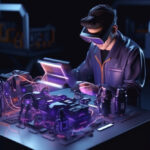Virtual Foundations: Building Tomorrow’s Architecture Today through VR

Virtual Reality (VR) has emerged as a revolutionary force in various industries, and its impact on architecture is nothing short of transformative. Architects and designers are now leveraging VR technology to enhance their creative processes, improve collaboration, and revolutionize the way they approach projects.
Enhanced Visualization
Architectural design often involves complex spatial concepts that can be challenging to convey through traditional drawings or 3D models. Virtual reality in architecture allows architects to step into their designs, providing an immersive experience that goes beyond what conventional mediums can offer. This enhanced visualization not only aids in understanding the spatial relationships within a design but also facilitates better communication with clients and stakeholders.
Improved Collaboration
In the realm of architecture, collaboration is key. VR enables architects, clients, and other stakeholders to collaborate in a virtual space, breaking down geographical barriers. Design teams can collectively explore and modify designs in real-time, fostering a more dynamic and efficient collaborative process. This level of interactivity ensures that everyone involved in a project is on the same page, leading to more cohesive and successful outcomes.
Streamlined Design Processes
Traditional design processes often involve numerous iterations, which can be time-consuming and resource-intensive. With VR, architects can rapidly prototype and iterate designs within the virtual environment. This streamlined process not only accelerates the design phase but also allows for quick and cost-effective adjustments based on client feedback. The result is a more agile and responsive approach to architectural design.
VR in Architectural Education
The integration of VR into architectural education is reshaping how aspiring architects learn and develop their skills. Students can now engage in immersive learning experiences, virtually exploring architectural masterpieces and historical structures. This not only enhances their understanding of architectural principles but also provides a firsthand look at different design styles and approaches.
Immersive Learning Experiences
VR offers students the opportunity to virtually “walk through” iconic buildings, experiencing the scale, proportions, and details in a way that traditional textbooks cannot capture. This immersive learning experience deepens their understanding of architectural concepts and fosters a greater appreciation for the built environment.
Simulation of Real-world Scenarios
In addition to historical exploration, VR allows students to simulate real-world architectural scenarios. From understanding the impact of natural lighting to experiencing the flow of foot traffic in a public space, students can gain valuable insights that bridge the gap between theoretical knowledge and practical application.
Skill Enhancement
VR serves as a powerful tool for skill enhancement, allowing students to practice design concepts and receive instant feedback within the virtual realm. This hands-on approach accelerates the learning curve, helping students develop essential design skills more efficiently.
Virtual Site Visits and Walkthroughs
One of the most impactful applications of VR in architecture is the ability to conduct virtual site visits and walkthroughs. This innovation has far-reaching implications for project management, client engagement, and overall project success.
Remote Project Inspections
Architects and project managers can use VR to remotely inspect project sites, identifying potential challenges and making informed decisions without the need for physical presence. This not only saves time but also reduces the costs associated with travel.
Client Engagement and Feedback
Presenting a design concept to clients can be a challenging task, as traditional renderings may not effectively convey the architect’s vision. VR changes this dynamic by allowing clients to virtually experience the proposed design. This immersive approach enhances client engagement and facilitates more constructive feedback, leading to designs that better align with the client’s expectations.
Cost and Time Savings
The efficiency gained through virtual site visits and walkthroughs translates to significant cost and time savings. Projects can progress more smoothly, with fewer unexpected hurdles. The ability to catch potential issues early in the design phase mitigates the risk of costly changes later on.
Challenges and Solutions
While the benefits of VR in architecture are substantial, challenges exist. Addressing these challenges is crucial for the widespread adoption and successful implementation of VR technology in the field.
Technical Constraints
VR technology is continually evolving, but some technical constraints still exist, such as hardware requirements and the need for robust software solutions. Architects must stay informed about advancements and choose VR solutions that align with their project requirements.
User Adaptation
Introducing VR into a workflow requires users to adapt to a new way of working. Training and support are essential to help architects and other stakeholders become proficient in using VR tools effectively. Overcoming resistance to change is a critical aspect of successful integration.
Integration with Existing Systems
For many architectural firms, integrating VR into existing design processes and software can be a challenge. Seamless integration requires careful planning and, in some cases, the development of custom solutions. Collaborating with experienced VR developers can ease this transition.
Future Trends in VR Architecture
The future of VR in architecture holds exciting possibilities, with ongoing technological advancements and innovative approaches to design.
Advancements in VR Technology
As VR technology continues to evolve, architects can expect more sophisticated hardware and software solutions. Improved graphics, enhanced interactivity, and greater accessibility will contribute to an even more immersive design experience.
Integration of Artificial Intelligence
The synergy between VR and artificial intelligence (AI) is a promising avenue for architectural design. AI algorithms can assist architects in generating design options based on specific criteria, allowing for more rapid exploration of creative possibilities.
Sustainable Design Practices
VR can play a vital role in promoting sustainable design practices. Architects can use VR to simulate the environmental impact of their designs, optimizing for energy efficiency and eco-friendly solutions. This aligns with the growing emphasis on sustainable architecture in the industry.
Case Studies
Examining real-world applications of VR in architecture provides valuable insights into the practical benefits and potential challenges of adopting this technology.
Successful Implementations
Architectural firms worldwide have successfully implemented VR in their design processes. Case studies showcase how VR has streamlined workflows, improved client satisfaction, and contributed to the overall success of projects.
Notable Architectural VR Projects
From interactive virtual museums to virtual walkthroughs of urban developments, there are notable examples of VR projects that have captivated audiences and demonstrated the potential of this technology in shaping the future of architecture.
Ethical Considerations in VR Architecture
As VR becomes more ingrained in architectural practices, ethical considerations must be taken into account to ensure responsible and inclusive use.
Privacy Concerns
Collecting and utilizing data within the VR environment raises privacy concerns. Architects must prioritize data security and transparency, outlining how user data will be handled and ensuring compliance with privacy regulations.
Accessibility Issues
Not all stakeholders may have equal access to VR technology, raising concerns about inclusivity. Architects should strive to create designs that consider a diverse range of users and explore alternative methods of engagement.
Responsible Implementation
Architects bear the responsibility of ethically implementing VR in their projects. This includes thoughtful consideration of the impact on communities, cultural sensitivity, and adherence to ethical standards in design.
The Role of VR in Urban Planning
Beyond individual architectural projects, VR is influencing the broader field of urban planning, contributing to the development of smarter and more sustainable cities.
Smart City Development
VR aids in visualizing and planning smart cities by simulating the integration of technology into urban landscapes. This facilitates informed decision-making in areas such as transportation, infrastructure, and public spaces.
Community Engagement
Engaging communities in the urban planning process is crucial for creating inclusive and livable cities. VR enables planners to showcase proposed developments in a way that resonates with residents, fostering greater community involvement.
Infrastructure Planning
From designing efficient transportation systems to optimizing energy infrastructure, VR provides a platform for architects and urban planners to collaboratively address the complex challenges of modern city development.
Comparison with Traditional Design Methods
While VR offers numerous advantages, it is essential to compare its efficacy with traditional design methods to provide a balanced perspective.
Pros and Cons
The benefits of VR, such as enhanced visualization and streamlined collaboration, must be weighed against potential drawbacks, including initial implementation costs and the learning curve associated with new technology.
Impact on Creativity
Some argue that the immersive nature of VR may limit creativity by imposing constraints on the virtual environment. Others believe that the benefits, such as rapid prototyping, ultimately enhance creative exploration.
Return on Investment
Architectural firms considering the adoption of VR must evaluate the potential return on investment. While initial costs may be significant, the long-term benefits in terms of efficiency and client satisfaction can outweigh these expenses.
Real-world Applications of VR in Architecture
Exploring specific applications of VR in different architectural contexts provides a nuanced understanding of its diverse uses.
Residential Design
VR allows homeowners to virtually walk through their future residences before construction begins, providing a realistic preview of the layout and design. This not only enhances client satisfaction but also reduces the likelihood of design changes during construction.
Commercial Spaces
In the realm of commercial architecture, VR is used to design and visualize retail spaces, offices, and other commercial structures. Stakeholders can explore the functionality and aesthetics of the space in a detailed and immersive manner.
Public Infrastructure
For large-scale public infrastructure projects, VR is employed to simulate the impact on the surrounding environment and assess the feasibility of the design. This aids in making informed decisions and mitigating potential issues during construction.
Expert Opinions on VR in Architecture
Gaining insights from architectural firms, VR developers, and end-users provides a well-rounded perspective on the practical implications and future trajectory of VR in architecture.
Architectural Firms’ Perspectives
Leading architectural firms share their experiences with integrating VR into their design processes, highlighting the advantages, challenges, and lessons learned.
Insights from VR Developers
The developers behind VR technologies offer their perspectives on the evolution of VR in architecture, addressing the technical advancements and future possibilities of this dynamic field.
User Feedback and Experiences
Feedback from users who have experienced VR in architectural contexts provides valuable insights into the user experience, satisfaction levels, and areas for improvement.
Overcoming Skepticism and Resistance
As with any technological innovation, skepticism and resistance to change are common hurdles that architects may face when introducing VR into their workflows.
Educating Stakeholders
Educating clients, team members, and other stakeholders about the benefits of VR is crucial for overcoming skepticism. Demonstrating the tangible advantages, such as improved collaboration and enhanced design visualization, can alleviate concerns.
Demonstrating Tangible Benefits
Architects must showcase real-world examples of successful VR implementations, emphasizing how the technology has positively impacted design processes, client satisfaction, and project outcomes.
Industry Advocacy
Advocacy within the architectural community can play a significant role in promoting the widespread adoption of VR. Sharing success stories, best practices, and resources can foster a supportive environment for embracing innovative technologies.
Conclusion
In conclusion, virtual reality has become a game-changer in the field of architecture, offering unprecedented opportunities for enhanced design processes, collaborative workflows, and immersive learning experiences. As technology continues to advance, the integration of VR in architecture will likely become more seamless and pervasive.
The dynamic landscape of VR in architecture requires architects to adapt, embrace innovation, and navigate challenges responsibly. The potential benefits, from cost and time savings to improved design outcomes, make the incorporation of VR a compelling proposition for architectural professionals.
FAQs
Q1: How is VR transforming the traditional architectural design process?
VR transforms the traditional architectural design process by providing enhanced visualization, streamlining collaboration, and facilitating rapid prototyping. Architects can immerse themselves in their designs, improving communication with clients and stakeholders.
Q2: What are the potential drawbacks of implementing VR in architecture?
Potential drawbacks include initial implementation costs, the learning curve associated with new technology, and concerns about data privacy. However, the long-term benefits often outweigh these challenges.
Q3: Are there any notable examples of successful VR projects in architecture?
Yes, numerous architectural firms have successfully implemented VR in their design processes, resulting in streamlined workflows, improved client satisfaction, and successful project outcomes.
Q4: How can architects address privacy concerns when using VR technology?
Architects can address privacy concerns by prioritizing data security, being transparent about data handling practices, and ensuring compliance with privacy regulations.
Q5: Is VR in architecture suitable for small-scale projects?
Yes, VR in architecture is suitable for small-scale projects, offering benefits such as enhanced visualization, improved collaboration, and cost-effective rapid prototyping.

The Financial Side of Moving: Budgeting and Saving Tips

Making Memories: International Rakhi Celebrations and Traditions

What Makes the #1 Ranked Email Data Service Essential for Your Business?

Pre-Requisites Before Applying for an Instant Personal Loan

Embrace the Magic of Turkey: An Unforgettable Visit

How to Summarize a Report Accurately in Seconds

Project Management and Accounting in Dynamics 365

2024 "Go Green With Taiwan" Kicks Off: Calling for Proposals Worldwide, Taiwan Joins Forces with the International Community to Create a Sustainable Future








